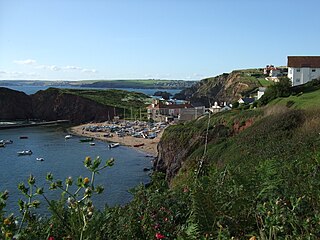Related Research Articles

Fair Isle, sometimes Fairisle, is the southernmost Shetland island, situated roughly 38 kilometres from the Shetland Mainland and about 43 kilometres from North Ronaldsay.

Tobermory is the capital of, and until 1973 the only burgh on, the Isle of Mull in the Scottish Inner Hebrides. It is located on the east coast of Mishnish, the most northerly part of the island, near the northern entrance of the Sound of Mull. The village was founded as a fishing port in 1788; its layout was based on the designs of Dumfriesshire engineer Thomas Telford. It has a current population of about 1,000. It is notable for appearing in the 2002–05 children's programme Balamory by the BBC.

Spanish Point is a village in the parish of Milltown Malbay in County Clare on the west coast of Ireland. It has many holiday homes, and in winter a significantly smaller population. The Beach, over a kilometre long, has Blue Flag Status and is suitable for swimming and surfing. It is also one of the better known surf breaks in County Clare. The name refers to the wrecking of some ships of the Spanish Armada off the coast.

The Spanish Armada was a Spanish fleet that sailed from Lisbon in late May 1588, commanded by Alonso de Guzmán, Duke of Medina Sidonia, an aristocrat without previous naval experience appointed by Philip II of Spain. His orders were to sail up the English Channel, join with the Duke of Parma in Flanders, and escort an invasion force that would land in England and overthrow Elizabeth I. Its purpose was to reinstate Catholicism in England, end support for the Dutch Republic, and prevent attacks by English and Dutch privateers against Spanish interests in the Americas.
The Spanish Armada in Ireland refers to the landfall made upon the coast of Ireland in September 1588 of a large portion of the 130-strong fleet sent by Philip II to invade England.
El Gran Grifón was the flagship of the Spanish Armada's supply squadron of Baltic hulks ; see List of Ships of the Spanish Armada. She was shipwrecked on Fair Isle, Shetland, Scotland, on 27 September 1588.

Hope Cove is a small seaside village within the civil parish of South Huish in South Hams District, Devon, England. It is located 5 miles (8.0 km) west of Salcombe and 5 miles (8.0 km) south west of Kingsbridge. It has two beaches, and is sheltered by the headland of Bolt Tail.
Stoneykirk is an area and a village in the heart of the Rhins of Galloway, Wigtownshire, in the administrative council area of Dumfries and Galloway, Scotland nearly 10 miles (16 km) in length and 3+1⁄2 miles (5.6 km) in breadth, bounded on the east by the bay of Luce, and on the west by the Irish Channel, 5 miles (8 km) south of Stranraer.
The San Juan de Sicilia was one of the 130 ships that formed the ill-fated Spanish Armada of 1588. The ship was originally known as the Brod Martolosi, before it was seized to form part of the navy. It was one of 10 ships forming the Levant squadron, one of 8 squadrons that formed the entire armada.
William Ashby or Asheby was an English politician and a diplomat sent to Scotland.
Black Watch was a large full-rigged ship built by Windsor shipbuilder Bennett Smith in Windsor, Nova Scotia. It was the last ship built by Smith in Windsor.
Events from the year 1588 in the Kingdom of Scotland.
The San Esteban was a ship of the Spanish Armada that was wrecked on the west coast of Ireland in 1588. All the survivors were killed when they reached the shore or taken prisoner and later hanged.
The Fair Isle Channel, also known as the Fair Isle Gap, is a body of water in northeast Scotland in the North Sea separating the Orkney Islands from the Shetland Islands. It is so named because of the presence of the Fair Isle, one of the Shetland Islands, which is located near its center.

A zabra (zah-brə) was a small or midsized sailing vessel used off the coasts of Spain and Portugal to carry goods by sea from the 13th century until the mid-16th century; they were well-armed to defend themselves against pirates and corsairs.

Sydney Wignall was a British marine archaeologist, climber, explorer and spy.

Quendale is a settlement and coastal district in the southwest area of Dunrossness in Shetland. Quendale beach is a long beach formed at the north end of the Bay of Quendale. Quendale beach is the longest beach in Shetland and the beach has extensive sand dunes.
References
- ↑ Gould, Richard A. (2011). "Ships of the great age of sail". Archaeology and the Social History of Ships (second ed.). Cambridge, England: Cambridge University Press. p. 232. ISBN 978-0-521-19492-1.
- ↑ "El Gran Grifon: Stroms Heelor, Fair Isle, North Sea". Canmore. Archived from the original on 24 September 2016.
- ↑ "The Wreck of El Gran Grifón". The Scotsman. 14 February 2005. Archived from the original on 5 March 2016.
- ↑ Ken Douglas (25 September 2009). The Downfall of the Spanish Armada in Ireland: The Grand Armada Lost on the Irish Coast in 1588. Gill Books. ISBN 978-0-7171-5149-3.
- ↑ Martin, Colin J. M. (1975). Full Fathom Five: Wrecks of the Spanish Armada. New York: Viking. pp. 156–187. ISBN 978-0-670-33193-2.